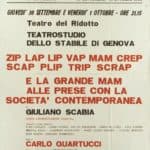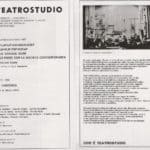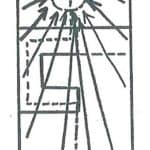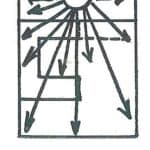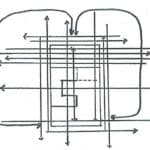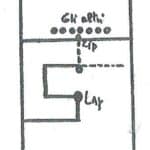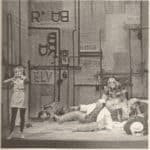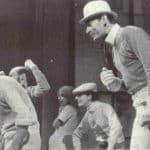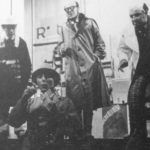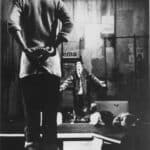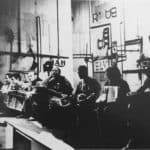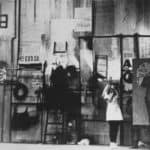Zip-lap-lip-vap-mam-crep-scap-plip-trip-scrap e la grande mam alle prese con la società contemporanea. (1965)
text by Giuliano Scabia
from an idea by Carlo Quartucci
directed by Carlo Quartucci
set and costume designs by Emanuele Luzzati
with Luigi Castejon, Cosimo Cinieri, Leo de Berardinis, Sabina de Guida, Anna D’Offizi, Mirella Falco, Giampiero Forteleoni, Maria Grazia Grassi-ni, Claudio Remondi, Edoardo Torricella
production Studio Theater of the Teatro Stabile of Genoa
premiere XXIV Prose Festival of the Venice Biennale, Teatro del Ridotto, 30 September 1965
La messinscena “acentrica” di Zip-Lap-Lip-Vap-Mam-Crep-Scap-Plip-Trip-Scrap e la Grande Mam alle prese con la società contemporanea: la questione dell’avanguardia divide la critica
by Daniela Visone
In Prima Porta Zip was put to the test for the first time: a theatrical work in progress, a group effort realized by the author, the director, the actors, the set designer, the musician and the technicians, even during the drafting stage of the text. All’improvviso and Zip saw Giuliano Scabia’s debut as a playwright, despite the fact that he had already done some stage writing in his relationship with exponents of the New Music, in particular Luigi Nono, whom Scabia had met during the play Intolleranza in 1960, for which in 1964 he had written La fabbrica illuminata. In close contact with Carlo Quartucci and his directing style, […] Scabia began to address the problem of the relationship between text and stage, between writing and physical space. His research crystallized in his invention of a new “acentric” stage space which radically changed the relationship between stage and audience, by exploiting a perceptual situation of plural perspective, which enabled spectators to get into close proximity to the theatrical event. By changing the idea of space he also changed the idea of the dramatic text, since space was an integral part of dramatic writing. For this, the writing had to contain, in addition to dialogue, a list of everything that could happen on stage – descriptions of light, tone, gestures, movement. The author thus created a complete text, of which no single element took precedence, since there was no longer a distinction between dialogue and stage directions. The period in which this project was realized can be divided into three phases. We can trace the first phase of preparation in January 1965, when Scabia began to take some of Quartucci’s cues on how to structure a text. The second phase took place in February-March of that year, when Scabia and Quartucci, with the support of the Teatro Stabile of Genoa, proposed Zip to the Biennale Theatre Festival of Venice. “The Venice Festival agreed to do Zip. The Teatro Stabile di Genova also entered the fray, ‘to get the show on the road,’ as Squarzina said. All told, between the Biennale and the Stabile, we had a play budget of 3,400,000 lire. Sets, costumes, actors’ pay, theater rent for rehearsals, unforeseen circumstances. The actors’ and directors’ pay came to 3000 lire per day. We rehearsed in Rome. The Zip text was delivered to the Biennale and the Stabile with a modifiability clause. It was a text that had to be adapted to the stage, the individual actors, so it could be subject to substantial changes.” The third stage came when Giuliano Scabia met the actors in Quartucci’s troupe, the moment for the project’s concrete realization, when the text was rehearsed for the first time with the actors – or we might say on the actors – and with set designer Emanuele Luzzati. The work took place in Prima Porta, at a makeshift camp built along the bend of the Tiber, where the actors involved in the Beckett Festival had moved to. Here Scabia was able to integrate his original idea and the characters his imagination had given birth to, by working closely with the actors. The text developed gradually: Scabia “acted” patiently on the character-masks, grasping their corporeality and continual reference to contemporary reality (especially politics), to link the dramaturgical writing as much as possible to the stage writing […]
Documents are published in original language. In case the translation is present, both the original and the translation are published.
Giuliano Scabia, Zip Lap Lip Vap Mam Crep Scap Plip Trip Scrap & la Grande Mam, in Giuliano Scabia, All'Improvviso & Zip, Enaudi, Turin 1967.
C. Quartucci, G. Scabia, Per un'avanguardia italiana «Sipario», n. 235, 1965.
Carlo Quartucci, Note di regia, estratto dal Catalogo del XXIV Festival Internazionale del Teatro di Prosa, Venezia, 1965, poi in Edoardo Fadini, Carlo Quartucci, Viaggio nel Camion dentro l’avanguardia ovvero la lunga cinematografia teatrale 1960-1976, Cooperativa Editoriale Studio forma, Turin 1976.
Giuliano Scabia, Nota su Zip, in Giuliano Scabia All'Improvviso & Zip, Enaudi, Turin 1967.
Carlo Quartucci, Osservazioni su Zip, excerpt from the "Giornale del Teatro Stabile di Genova", 1965, then in Edoardo Fadini, Carlo Quartucci, Viaggio nel Camion dentro l’avanguardia ovvero la lunga cinematografia teatrale 1960-1976, Cooperativa Editoriale Studio forma, Turin 1976.
Carlo Quartucci, Sette anni di esperienze, «Teatro», 1967
Giuliano Scabia Teatro di avvenimenti, report at the Ivrea Conference for a new theater, «Sipario», n.255, July 1967.
Edoardo Fadini, Carlo Quartucci, Esplosa la scatola teatrale, in Edoardo Fadini, Carlo Quartucci, Viaggio nel Camion dentro l’avanguardia ovvero la lunga cinematografia teatrale 1960-1976, Cooperativa Editoriale Studio forma, Turin 1976.
Giuliano Scabia, Nello spazio del teatro, «Teatro», II, n.2, 1967-1968.
Zip Lap Lip Vap Mam Crep Scap Plip Trip Scrap & la Grande Mam alle prese con la società contemporanea,
1965,
photographs taken from Edoardo Fadini, Carlo Quartucci, Viaggio nel Camion dentro l’avanguardia ovvero la lunga cinematografia teatrale 1960-1976, Cooperativa Studio Forma, Turin 1976.
published in «Sipario», n. 235, novembre 1965.
Ettore Capriolo Zip Lap Lip Vap Mam Crep Scap Plip Trip Scrap & la Grande Mam alle prese con la società contemporanea, «Sipario», n. 235, November 1965.
Marco De Marinis, Il caso "Zip", in Marco De Marinis, Il Nuovo Teatro 1947 – 1970, Bompiani, Milan, 1987.
Antonio Morgese, Il cammino difficile del nuovo teatro, in Edoardo Fadini, Carlo Quartucci, Viaggio nel Camion dentro l’avanguardia ovvero la lunga cinematografia teatrale 1960-1976, Cooperativa Editoriale Studio forma, Turin 1976.
Carlo Quartucci, Teatro stabilizzato e teatro evolutivo, «Sipario», n. 253, maggio 1967.
Alla ricerca della lingua del tempo. Conversazione con Giuliano Scabia, di Massimo Marino, La lunga intervista fa parte dei materiali pubblicati sulla rivista Doppio Zero in occasione degli ottant'anni di Giuliano Scabia. Interessante la narrazione rispetto la genesi di Zip e l'interazione con il regista, Carlo Quartucci.

